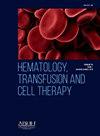Annualized bleeding rate in hemophilia A patients in Brazil: a systematic review
IF 1.8
Q3 HEMATOLOGY
引用次数: 0
Abstract
Background
Hemophilia A is an X-linked chronic bleeding disorder due to deficiency of the coagulation factor VIII. According to the residual level of FVIII activity, patients can present with severe (FVIII levels <1 %), moderate (1–5 %) or mild (6–40 %) phenotypes. While long-term prophylaxis is the current standard of care and has been shown to be effective in minimizing bleeding episodes, episodes of hemarthrosis, that could lead to arthropathy and disability, are still reported. This systematic review aimed to evaluate available data concerning current treatment outcomes in severe hemophilia A patients without inhibitors in Brazil, focusing on the frequency of bleeding episodes and adherence to therapy of patients under prophylactic treatment.
Method
A literature search strategy was used in the MEDLINE (via PubMed), Embase, LILACS and SciElo databases from 2014 onwards, since it was the moment that prophylaxis effectively became available in the Brazilian National Health Service, even though prophylactic treatment had been officially incorporated in 2011 focused on concerning bleeding episodes and adherence rate of this population.
Results
Searches yielded 536 articles. After removal of duplicates, 417 articles were screened for eligibility. Eventually, 104 articles were selected for full-text assessment. Finally, only five publications met eligibility criteria and were selected for the descriptive review.
Conclusion
Available information on efficacy of severe hemophilia A management in Brazil currently relies on scarce and possibly biased information. It should be strongly emphasized that Brazil is in great need of a structured and coordinated effort to improve collection, analysis, and reporting of data on hemophilia A patients.
巴西A型血友病患者的年出血率:一项系统综述
血友病A是一种由凝血因子VIII缺乏引起的x连锁慢性出血性疾病。根据FVIII活性残留水平,患者可表现为重度(FVIII水平为1%)、中度(1 - 5%)或轻度(6 - 40%)表型。虽然长期预防是目前的护理标准,并已被证明在减少出血发作方面有效,但仍有可能导致关节病变和残疾的关节血肿发作的报道。本系统综述旨在评估巴西无抑制剂严重血友病A患者当前治疗结果的现有数据,重点关注出血发作的频率和预防性治疗患者的治疗依从性。方法从2014年起在MEDLINE(通过PubMed)、Embase、LILACS和SciElo数据库中使用文献检索策略,因为这是巴西国家卫生服务有效提供预防的时刻,尽管预防性治疗已于2011年正式纳入,重点关注该人群的出血发作和依从率。结果搜索产生了536篇文章。在去除重复项后,筛选了417篇文章。最终选择104篇文章进行全文评估。最后,只有五个出版物符合资格标准,并被选中进行描述性审查。结论目前关于巴西严重A型血友病治疗疗效的现有信息依赖于稀缺且可能存在偏差的信息。应该强烈强调的是,巴西非常需要有组织和协调的努力,以改进血友病a患者数据的收集、分析和报告。
本文章由计算机程序翻译,如有差异,请以英文原文为准。
求助全文
约1分钟内获得全文
求助全文
来源期刊

Hematology, Transfusion and Cell Therapy
Multiple-
CiteScore
2.40
自引率
4.80%
发文量
1419
审稿时长
30 weeks
 求助内容:
求助内容: 应助结果提醒方式:
应助结果提醒方式:


